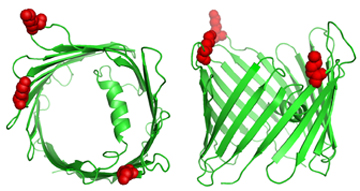 The VDAC3 mitochondrial pore is ubiquitylated on 3 lysine residues, shown in red, on the cytoplasmic surface on mitocohndria. The membrane protein makes a channel through which molecules can be transported. Ubiquitylation could potentially affect this trafficking. Image courtesy of the Harper Lab.
The VDAC3 mitochondrial pore is ubiquitylated on 3 lysine residues, shown in red, on the cytoplasmic surface on mitocohndria. The membrane protein makes a channel through which molecules can be transported. Ubiquitylation could potentially affect this trafficking. Image courtesy of the Harper Lab.
Cell biologists studying Parkinson’s disease are training their sights on mitochondria, the energy source of the cell, whose activity in neurons appears to go awry in this devastating neurodegenerative illness. A neuron needs its mitochondria to be healthy and mobile, particularly during their continual cycles of fission and fusion in which damaged bits are removed and healthy mitochondria are renewed.
A particular gene that is mutated in early-onset Parkinson's—a subset of the disease that can strike people in their 30s—has opened a window into a mechanism called mitophagy, an important component in this form of cellular housekeeping. When mitochondria are damaged, they must first be identified and then cleared away so they don’t fuse with and poison “good” mitochondria. In mitophagy, an unwanted mitochondrion is engulfed and degraded.
Fundamental biochemical pathway
The gene PARKIN and its regulatory companion PINK1 work together in this process, one that involves multiple proteins on the mitochondrial outer membrane that may ultimately serve as potential targets for treatments in Parkinson’s. PARKIN was discovered a dozen years ago, but only within the last couple of years have scientists pinpointed its role in mitochondrial quality control.
Wade Harper, the Bert and Natalie Vallee Professor of Molecular Pathology, together with his collaborator Steven Gygi, HMS professor of cell biology, led an HMS Department of Cell Biology team that has identified a fundamental biochemical pathway in which PARKIN resculpts the mitochondrial proteome—the full complement of mitochondrial proteins produced—to promote mitophagy. Harper and his colleagues published their results in Nature this week and share a web portal with a wealth of information about the proteins in this pathway.
The pathway that eradicates damaged mitochondria begins with a process called ubiquitylation. Ubiquitin is a small protein that modifies other proteins in many aspects of biology, including the response to damage that ultimately ends in ridding the cell of such waste. Understanding the sites of modification in target proteins is a key step in elucidating the role of ubiquitin in specific pathways, but this has been a technically challenging area of research. The Gygi and Harper labs recently developed a mass spectrometry-based proteomic methodology to identify ubiquitylation sites in target proteins, potentially on a global scale, and in the current study extended this to the PARKIN system.
Resculpting the mitochondrial proteome
“Identifying actual sites of ubiquitylation provides us not only a visual way to look at the structure and mechanisms of how the PARKIN system works, but it also gives you the potential in the future to make reagents that will let you look in tissue of the brain, for example, and determine whether the pathway is on or off,” said Harper.
In defining the near complete repertoire of PARKIN substrates—which they call the PARKIN-dependent ubiquitylome—the researchers reveal how the structure and function of the mitochondrial proteome is resculpted byPARKIN. Indeed, their work identified hundreds of ubiquitylation sites on dozens of proteins.
While this contribution does not have immediate clinical implications, it does serve as a key steppingstone toward a greater understanding of Parkinson’s and perhaps other neurodegenerative diseases involving mitochondrial quality control. This challenging work is necessary before contemplating ways to somehow overcome defects in genes such as PARKIN.
“We want to be able to use the data to understand in more detail howPARKIN is regulated and how it is activated and how it is capable of ubiquitylating a dizzying array of proteins on the mitochondrial surface,” Harper said. “In addition, we also want to try to test the hypothesis that ubiquitylation of specific mitochondrial proteins is critical for mitophagy.”
I am definitely enjoying your website. You definitely have some great insight and great stories.
ReplyDeleteلدغة البق